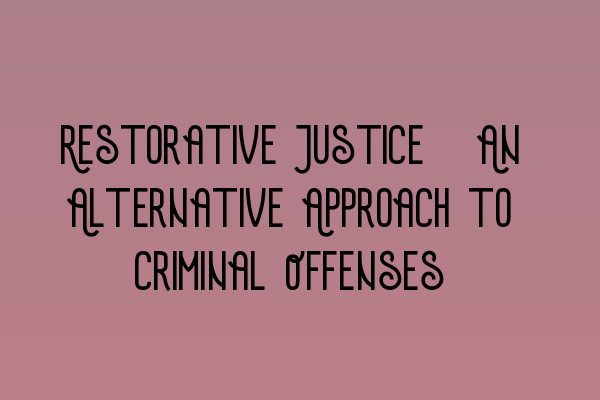Restorative Justice: An Alternative Approach to Criminal Offenses
Crime is an unfortunate reality in any society, and the traditional criminal justice system has long focused on punishment and retribution. However, there is a growing recognition of the limitations of this approach and the need for alternative methods to address the harm caused by criminal offenses. One such alternative is restorative justice, which aims to repair the harm caused to victims, communities, and offenders themselves.
Restorative justice is a victim-centered approach that promotes dialogue, accountability, and rehabilitation. It focuses on addressing the needs of victims, giving them a voice, and supporting their healing process. Rather than isolating offenders, restorative justice seeks to involve them in repairing the harm they have caused and providing them with opportunities to make amends.
The Benefits of Restorative Justice
Restorative justice offers several benefits over the traditional criminal justice system. Firstly, it provides victims with a sense of empowerment and closure. By actively participating in the process, victims have the opportunity to express their feelings and have a say in how the harm caused is resolved. This can help them find emotional healing and move on with their lives.
Secondly, restorative justice promotes greater accountability for offenders. Rather than simply serving a prison sentence, offenders are encouraged to reflect on their actions, take responsibility, and actively work towards repairing the harm they have caused. This can lead to a higher level of rehabilitation and reduce the likelihood of reoffending in the future.
Another significant benefit of restorative justice is its positive impact on communities. By involving community members in the process, it fosters a sense of collective responsibility and encourages community building. This collaborative approach helps to rebuild trust and restore social bonds that may have been damaged by the crime.
How Does Restorative Justice Work?
Restorative justice involves various processes that can be tailored to suit the specific needs of each case. One common approach is victim-offender mediation, where a trained mediator facilitates a face-to-face meeting between the victim and the offender. During this meeting, the victim has the opportunity to share their experiences and ask questions, while the offender can express remorse and take responsibility for their actions.
Another process often used in restorative justice is community conferencing. This involves bringing together all affected parties, including the victim, offender, their respective support networks, and community members. The purpose of the conference is to discuss the harm caused, explore possible solutions, and develop a plan for repairing the harm and preventing future offenses.
It’s important to note that restorative justice does not replace the criminal justice system but rather operates alongside it. It can complement traditional approaches by offering a more holistic and inclusive response to crime.
Conclusion
Restorative justice provides a refreshing alternative to the punitive approach of the traditional criminal justice system. By focusing on repairing harm, promoting accountability, and fostering community involvement, it offers a more balanced and humane response to criminal offenses.
If you would like to learn more about the SQE Criminal Law & Practice and how it relates to restorative justice, feel free to explore our related articles:
SQE 1 Practice Exam Questions,
SQE 1 Practice Mocks FLK1 FLK2,
SQE 2 Preparation Courses,
SQE 1 Preparation Courses, and
SRA SQE Exam Dates.
